#regionalist art
Text
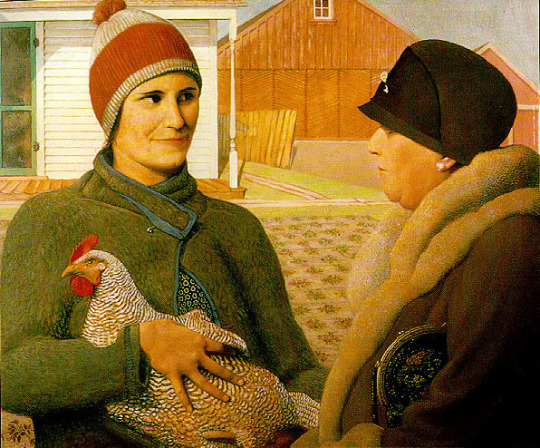
Grant Wood
The Appraisal
1931
#grant wood#american artist#american art#american painter#american painting#american regionalism#regionalist art#regionalist#regionalism#portrait#portrait painting#chickens#farm animals#modern art#art history#aesthetictumblr#tumblraesthetic#tumblrpic#tumblrpictures#tumblr art#aesthetic#beauty
47 notes
·
View notes
Text

#grant wood#american artist#american art#american painter#american painting#american regionalism#regionalist art#regionalist#regionalism#portrait#portrait painting#chickens#farm animals#modern art#art history#art#painting#oil painting#oil on canvas#artwork#handmade#art blog
16 notes
·
View notes
Photo




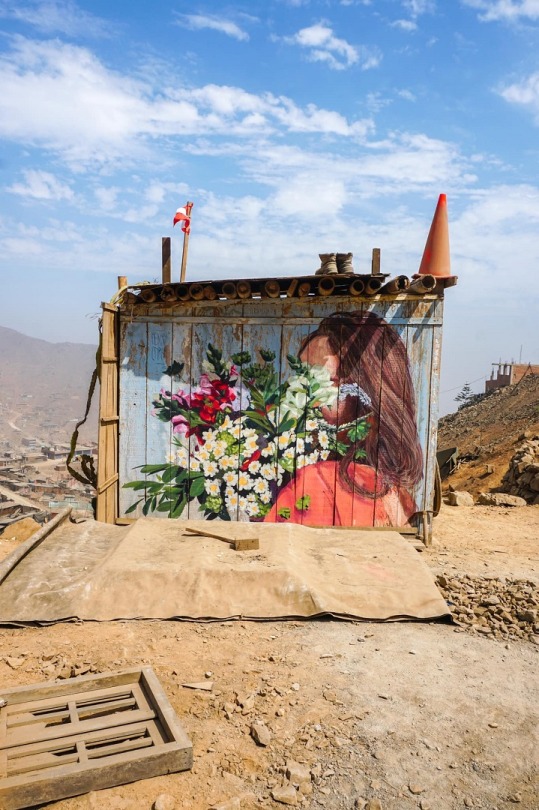


Henry Chram
#henry chram#street art#urban intervention#muralism#wall paintings#pop culture#south american artist#beautiful nature#regionalist art
102 notes
·
View notes
Text
John Rogers Cox, Gray and Gold.

5 notes
·
View notes
Text
Andrew Wyeth: The Helga Pictures :: John Wilmerding
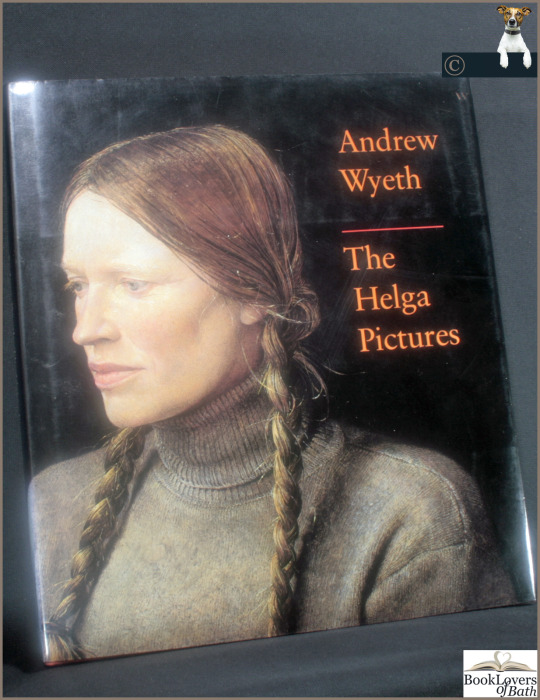
View On WordPress
#0-8109-1788-2#american painters#american portraits#art pennsylvania#books by john wilmerding#female artists#first edition books#interpretation artists#interpretation painters#interpretation painting#j carter brown#national gallery art washington#realist painting#regionalist styles#women artists
0 notes
Text
Where Andrew Wyeth shows a Wabi Sabi Aesthetic
Andrew Wyeth’s art is often associated with the concept of wabi-sabi, a Japanese aesthetic philosophy that values the beauty of impermanence, imperfection, and incompleteness. Wyeth’s paintings are characterized by their simplicity, muted color palette, and attention to detail, which contribute to their overall sense of tranquility and quiet contemplation. In this essay, I will explore where we…

View On WordPress
#Aesthetics#art#art critique#art education#art history#Artist#Artwork#creativity#Expressionism#inspiration#painting#Regionalist#wabi sabi#Wyeth
1 note
·
View note
Photo

Thomas Hart Benton
Cave Spring, 1963
Tempera on Panel
Nasher Museum of Art at Duke University
#art#art history#american art#american artist#thomas hart benton#painting#tempera#panel#regionalism#regionalist#landscape#cave spring#nasher museum of art#duke university
0 notes
Note
Who are some of your biggest influences in your art?
I’ve answered this question or something like it a couple times (1 2 3 4 + archive of interviews I’ve done with people) so I’ll hit the main points and then talk about some different stuff I’ve been into recently.
Favorite artists who have influenced me the most in no particular order:
Wayne Barlowe
Moebius
Mark Schultz
Simon Roy
Cosimo Galluzi
CM Kosemen
John Howe
James Gurney
Katsuya Terada
Hayao Miyazaki
I could name more, but those are the main people that I come back to, year after year.
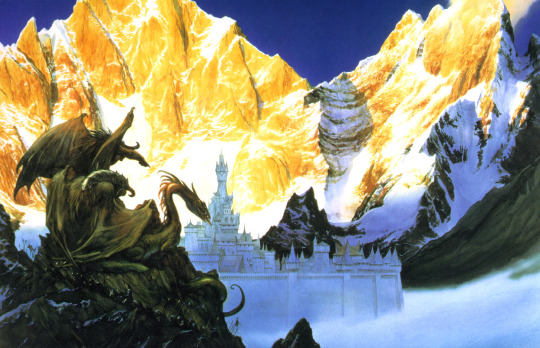
Picture above by John Howe
General art movements/styles that have influenced me
19th century academic art, especially Orientalist painters (to be clear, I don’t endorse any of the harmful racial attitudes behind many of them, it’s just stuff that I saw as a kid that I thought looked cool and different and mysterious)
Ukiyo-e, Shin Hanga, Japanese woodcuts generally
Late 80s to 90s anime
Most comic art
Online spec bio art communities
Video game character/creature designs: Sonic, Pokemon, Legend of Zelda, Shining Force, etc
Art Nouveau
Fuck it, basically all Gilded Age, Fin de siècle, Belle Époque, late 19th/early 20th century European art movements that were more or less representational or illustrative

Picture above by Ludwig Deutsch. I had a bookmark of this painting for many years and I would often get distracted while reading and just stare at it.
I think I’ve talked about all that stuff before but if you want more details or specifics just ask!
For the last couple years, my really big influences have all been other artists I’ve met online. I mean I made a whole book with @ordheist and @bagb0ss. There’s a sort of loose cloud of (mostly) SFF artists that I’ve been really lucky to work and speak with and we all kinda know or know of each other or end up in the same Discord servers, or working on the same RPGs, etc. I’m not gonna link everybody but if you go through the interviews I’ve conducted for my newsletter or check out my side blog you’ll start to figure out who I mean (seriously a lot of these people are coming to tumblr now from twitter and I’ve been reblogging the hell out of them.) Seeing all the stuff my peers are putting out and talking with them is the source of like 90% of the ideas for my personal illustrations these days. It’s cool to be part of a community. I wish there were more opportunities to meet in person, but it’s still cool.
The other stuff that’s really been in my head lately is art that’s less illustrative, more abstract and graphical. Not pure abstraction mind you, but I’ve really been digging stuff that’s more about communicating a concept, feeling, piece of information, or idea than a narrative. More about design and composition than rendering. I recently read Philip Meggs’ History of Graphic Design and that’s turned me on to so new many artists and styles. In particular I’ve fallen in love with all the Vienna Secession guys, the Glasgow Style artists, and all the graphic and bookmaking ideas that came out of the Arts and Crafts movement. I don’t know how I want to work these ideas into my drawings yet and I haven’t had a lot of time to experiment lately but they're definitely bouncing around in my head.


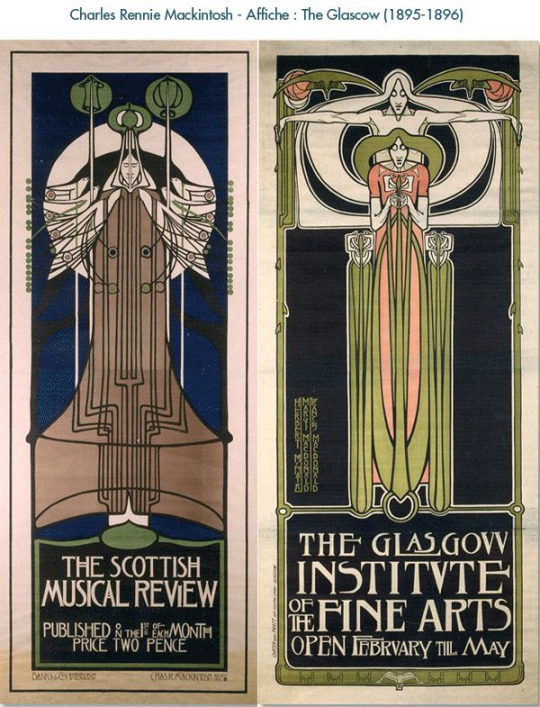

Above from top to bottom: two pieces by Koloman Moser, two posters by Frances Macdonald, and two pages from The Glittering Plain, written and designed by William Morris.
There’s a whole lot of art that I really love but it rarely gets reflected in my drawings- American Regionalist paintings, gig posters, childrens’ storybooks, Eastern European Mosaics, Native American art, outsider art, colonial Americana …. One day I’ll find a way to synthesize it all.
Anyway, hope this is interesting/fun/informative and if you have any follow up questions don’t hesitate to ask!
-Logan
#art nouveau#illustration art#vienna secession#arts and crafts movement#glasgow style#send me an ask!
68 notes
·
View notes
Photo

Thomas Hart Benton - Self portrait
Thomas Hart Benton (April 15, 1889 – January 19, 1975) was an American painter, muralist, and printmaker. Along with Grant Wood and John Steuart Curry, he was at the forefront of the Regionalist art movement.
76 notes
·
View notes
Photo
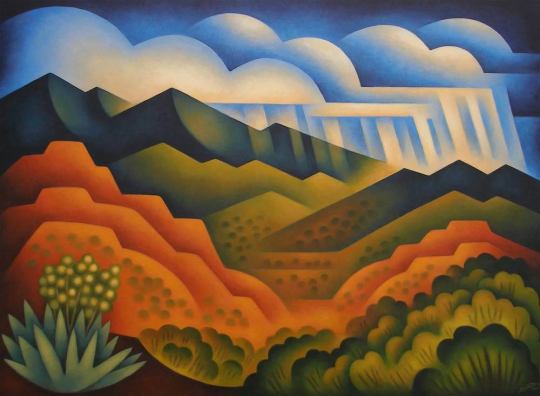
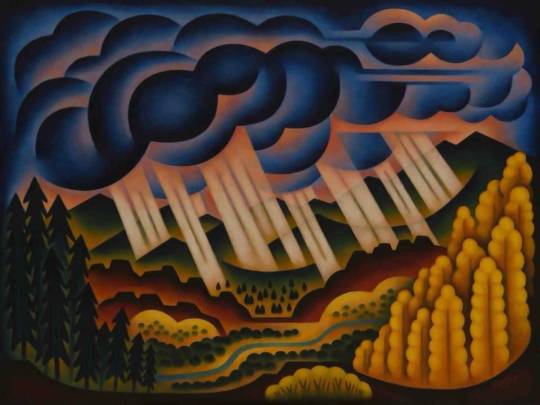



Sushe Felix says:
My work involves a combination of my ongoing interest in the American Regionalist and Modernist Art Movements from the 1930’s and 40’s and my desire to find new and different ways in which to depict the rhythms of life and the natural flow of motion found in nature. As a native of Colorado, I feel my work is all about the brilliant color, dramatic forms and shapes, and the intense lights and darks of the American Southwest."
21 notes
·
View notes
Text
Gscheitblöd

Das Nonseum - Eine Bühne für Querdenker
Museum Nonseum, Poysbrunnerstraße 9, 2171 Herrnbaumgarten
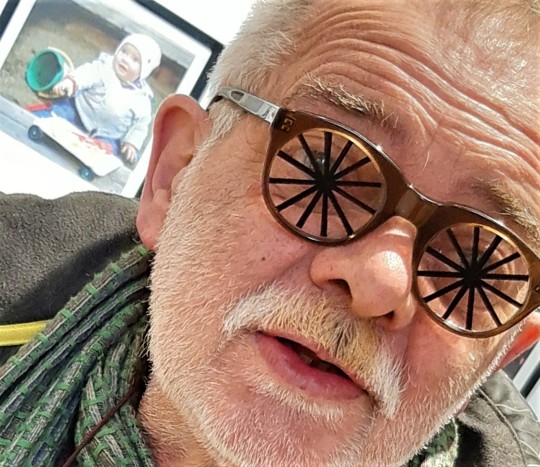
Der phantastische Regionalist Fritz Gall
Was haben die „Kunst des Scheiterns“, „Reziproker Unsinn“ oder „Die Absurdität der Logik“ gemeinsam? Sie sind das Ergebnis jahrelang betriebener Forschung der Denkfabrik „Verein zur Verwertung von Gedankenüberschüssen“, der am Flaschenhals des nordöstlichen Weinviertels seine Claims eingeschlagen hat. Schon alleine die Anreise lohnt, führt sie doch vorbei an den Säulenheiligen hiesiger Volkskultur: Grüner Veltliner, Welschriesling und Burgunder. An unüberschaubar weiten Anbauflächen, schmucken Weingärten und romantischen Kellergassen führt der Weg vorbei an Schänken und Bänken, Trauben und Lauben. Langsam aber zielgerichtet schluckt sich der Vespista durch regionale Edelreben, bis hin zu den Disponibilitäten der hübschen Marktgemeinde Herrenbaumgarten, Bezirk Mistelbach. Dort angekommen, geht’s erst richtig los. Lebensversteher und Schluckspechte kommen Glas um Glas auf ihre Rechnung. Im hiesigen „Nonseum“ nämlich ist der tiefe Unsinn zu Hause, verfügt das Haus doch über ein reichhaltiges Angebot an Erstaunlichem: Die Palette reicht vom mechanischen Nasen-Bohrer, hölzernen Ein-Tritt und würfelförmigem Tisch-Tuch, bis hin zum selbstgestrickten Trachten-Pärchen-Wärmer, eine Art „Loden-für-Hoden“. Hier gibt’s nichts wirklich, davon aber mehr als genug.
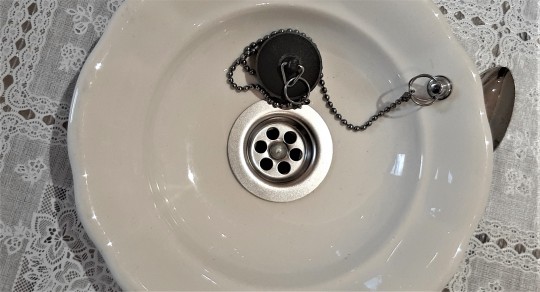
Suppenteller mit Abfluß
Vor dem „Zentrum zur Abkehr von Nützlichkeitsgedanken“ schwinge ich ab. Tiefer Sinn erschließt sich nur demjenigen, der zu denken gewillt ist. Für Flachwurzler ist das nichts, versteht sich das Institut doch als Bedarfsanstalt für Überlebensstrategien.
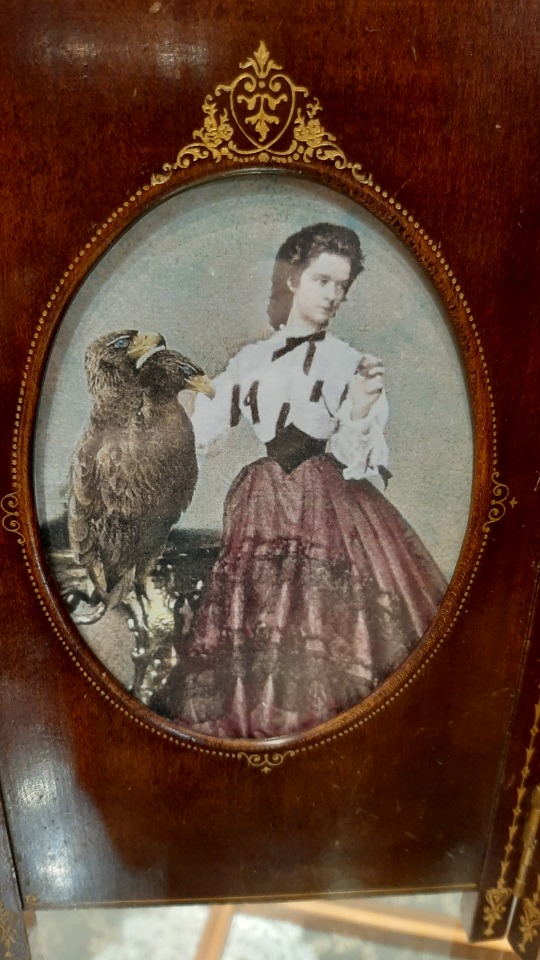
Sisi mit Doppeladlerkopf
Da ich für jede Art von Oberflächenberatung empfänglich bin, habe ich für heute einen Behandlungstermin gebucht. Pünktlich wie der Unsinn erscheine ich vor Ort - gut ausgeruht und, das vor allem, halbwegs nüchtern. Der „phantastische Regionalist“ und Bildhauer von Weltruf Fritz Gall, einer der Gründerväter der „Anstalt nonsealen Schwachsinns“, bittet mich, am Behandlungsstuhl Platz zu nehmen. „Hier werden alle Arten von Lebenshilfe gebaut, müssen Sie wissen“, sagt er, mustert mich mit einer Mischung aus Fachwissen und Desinteresse, und bevor ich noch antworten kann, eröffnet er die Sitzung mit einer Gewissensfrage: „Weiß oder Rot?“ Ich muss mich scheint‘s noch einhören in hiesige Terminologie, also frage ich: „Wie bitte?“, und ehe mein Gegenüber nach Luft schnappt, sage ich: „Espresso.“ Professor Gall zuckt mit den Achseln und schleppt sich zur Hausbar, direkt hinter der Museumskassa. Das Gespräch, kaum begonnen, ist jäh beendet. Ich blicke mich um. Klimbim und Kokolores, Kitsch und Klumpert. Ein Sammelsurium sinnloser Wichtigkeiten rundum: Der „Anonymitätsbalken zur Wahrung höchsteigenen Inkognitos“, der „Suppenteller mit integriertem Abfluss“, ein, im Fall der Fälle, „selbstfahrender Nachttopf“, oder, einer der Höhepunkte der Sammlung, das „Potjomkin’sche Knopfloch“ aus dem zweiten Drittel des achtzehnten Jahrhunderts. „Wenn wir schon beim Loch sind, die gibt’s bei uns in verschiedenen Größen, stilistisch quer durch die Epochen“, sagt Prof. Gall, der mich wohl schon eine Zeitlang beobachtet und auf ein paar Plastiksäckchen deutet. Ich bin, scheint’s, recht am Ort. All jene, die das Nichts suchen, werden hier fündig.
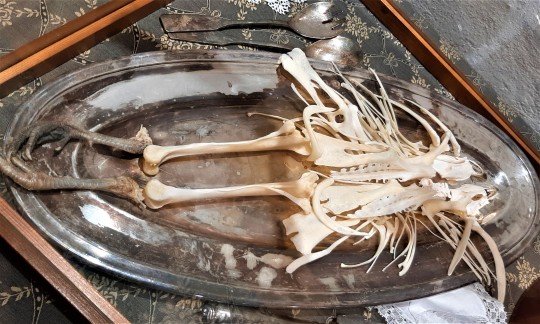
Originalskelett des letzten K.u.K. Doppeladlers
Der Herr Direktor platziert eine winzig kleine Schale auf ein Tischchen, darin ein tiefschwarzes Gebräu schwabbelt, als hätte er Holzkohle weichgekocht. „Wo waren wir stehen geblieben?“, fragt er und ich, der ich mich durch die Hitze des Getränkes kämpfe, bin kurz ratlos. „Richtig!“, sagt er, „Klamauk mag ich gar nicht.“ Er ruckelt einen Heizstrahler heran, dabei verheddert er sich im Kabel, sodass das Ungetüm ins Schwanken gerät und auf mich zu stürzen droht. Beide reißen wir die Arme hoch, dabei entgleitet ihm das Weinglas und mir schwappt die heiße Schlutze über die Hose. „No Problem“, flüstere ich, und er sagt: „Wir sind hier auf der Suche nach dem Missing Link für Situationen, die nicht gelöst sind. Das sollten Sie wissen.“ Darauf ich: „Der Gedanke ist mir soeben auch gekommen.“ Damit wäre das Wichtigste geklärt, wir können uns Nebensächlicherem widmen.
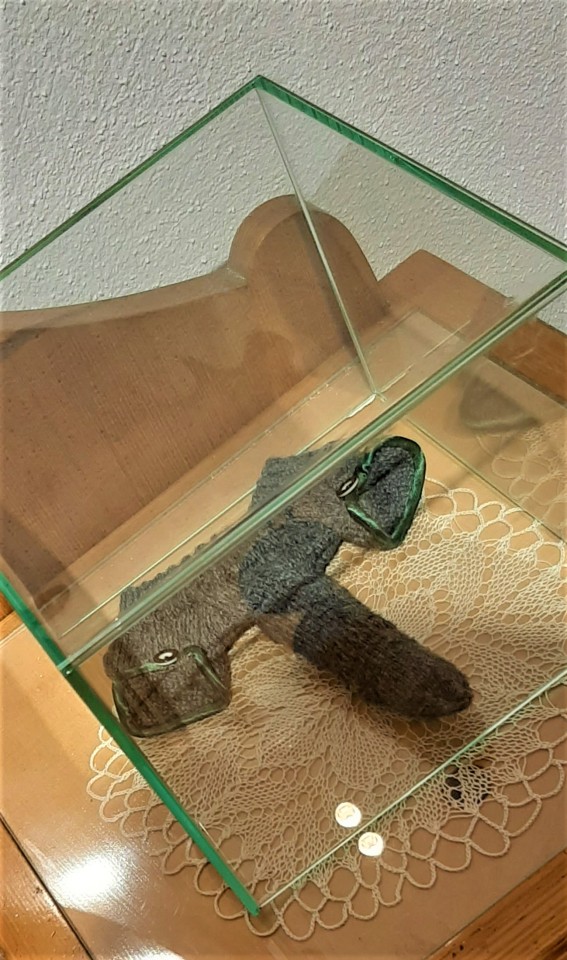
Trachtenpärchenwärmer
Herr Gall zündet sich ein Zigarettchen an und beginnt den Rundgang mit: „Scheitern ist Lernen“, worauf ich erwidere… ja, was sagt man da darauf? Ich grunze ein bisschen herum, womit sogar dieses Thema durch ist. Hernach wieseln wir kreuz und quer durch die Ausstellungsräume, vorbei an Vitrinen, Schaukästen und Glasschränken und ich staune und ich nicke und ich versuche weder-noch zu wirken, bloß nicht zu intelligent, aber keineswegs dümmlich. Ich bin reichlich verwirrt. „Unser Museum ist Freiraum“, sagt der Professor, „Wir entwickeln hier Dinge, die kein Mensch braucht. Die Optik aber, die muss stimmen. Verstehen Sie?“ Ich nicke. „Mit dem „Wandertag für Pessimisten“ haben wir die hiesige Zivilbevölkerung für uns gewonnen. Ein Riesenerfolg. Getoppt wurde der noch von der Veranstaltung „Handtuchwerfen für Politiker“. Von überall kamen sie angereist: Gemeinderäte, Mandatare, sogar ein Bürgermeister war dabei. Es war überwältigend. Und alle haben geworfen. Alle.“
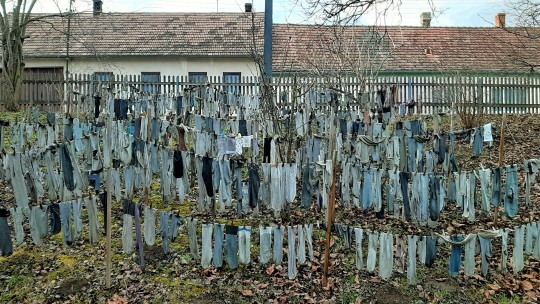
Das einzige Sockenhospiz des östlichen Weinviertels
In einem der Glaskästen sind ein paar Vogelknöchelchen ausgelegt. „Was ist das?“, frage ich. Herr Gall blickt mich streng an: „Eines unserer wertvollsten Exponate - das Skelett des österreichischen Doppeladlers.“ Gleich daneben liegt eine kolorierte Fotografie, auf der die Kaiserin Sisi zu sehen ist, neben ihr hockt ein Adler mit Vespentaille, aber zwei Köpfen. „Man hat die Knochen hier in einem Keller gefunden. Eine archäologische Sensation. Ging durch die gesamte Lokalpresse.“

Ins untere Reich des Friedl Umschaid
Der Herr Direktor öffnet eine Türe und gleitet hinaus in den noch winterschläfrigen Hof. Hier wartet die nächste Überraschung: Wäscheleinen, darauf jede Menge gekluppter Socken. „Wir sammeln Einzelstücke.“ „Leinen?“, frage ich, einfach um auch ein bisschen lustig zu sein. „Ein Hilfsprojekt…“, sagt Herr Gall streng, „Socken kommen von Natur aus paarweise auf die Welt, im Laufe der Jahre aber geraten sie in Gefahr, zu vereinzeln, so wie wir. Wissenschaftler beobachten das mit Sorge und eshalb gönnen wir ihnen hier ein Altern in Würde. Eine Art Sockenhospiz, wenn Sie so wollen. Die Anteilnahme der Bevölkerung ist überwältigend: Mit Schicksalsschlägen kann sich jeder identifizieren.“
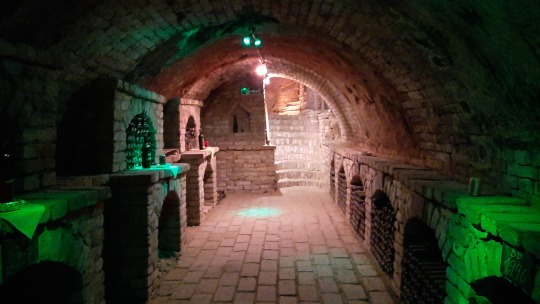
Im Labyrinthkeller
Und jetzt sprudelt’s nur so aus ihm heraus. Die Feder glüht: „Unser Verein ist aus der „1. Österreichischen Nonsens-Erfindermesse“ hervorgegangen. Bald danach kam das „24-Stunden-Weinbergschneckenrennen“, der „Seufzersteig“, auf dem die Teilnehmer so viel seufzen konnten, wie sie wollten („Oh mei!“, „Warum grad i?“), und die „Unglückskonferenz“, eine Kombi aus Krenreißen und Zwiebelschneiden, wobei eine Publikumsjury entschied, welcher Kandidat als erster heult.

Weinselige Unterwelt
Startschuss für unser Haus aber war das „Aufstellen von Vogelscheuchen“ (unzählige Besucher kamen und stellten ihre Scheuchen auf), der „Urstrumpf-, Erb- oder Milli-Tanten-Tag“, die „Denkumenta Triviale“ oder das „Festival der Gerüche - Wenn Nasen große Augen machen“, um nur einige wenige Beispiele zu nennen, die unser Haus groß machten.“

Die Theatralik des Weines
Seither gilt das „Nonseum“ den Gscheitblöden aus Nah und Fern als der Nabel ihrer geistigen Übernachtung. Ein weißer Fleck in der Topografie des Weinviertels wurde bunt, der Rand der Republik geriet zum Epizentrum von Spritz-Findigkeit. „Das Leben ist eine Lawine: Einmal rauf und einmal runter“, befand der jenseits unser aller Grenzen forschende Karl Valentin und - er sollte recht behalten. Aber auch hier, in tiefer Grundlosigkeit wird drauf los g’scheitelt, sdass es eine Freude ist: Herr Gall und seine Schutzbefohlenen denken, was der Kopf hergibt. Und das ist gar nicht wenig. Unsinn destilliert Weisheit, Weisheit Witz, Witz Nonsens und Nonsens Unsinn. Der Kreis schließt sich. Alles wird gut, aber nichts besser. Das ist wichtig. Die Welt wäre ärmer ohne die Gscheitblöden aus Herren- und Damenbaumgarten.

Trinken ist nicht gleich Trinken
So lange Fernsehstationen wie BBC oder ORF, Berichterstatter aus Südafrika, Korea oder Mauerbach sich zu ihnen bemühen, liegt ihr Haus keineswegs am Arsch der Welt. Und wenn schon, dann eben an einem besonders hübschen. So viel Ehre darf, soll, muss sein!

Im unterirdischen Paradies
#michael schottenberg#schotti#schotti unterwegs#schotti to go#Gscheitblöd#Nonsenseum#Friedl Umschaid#Herrenbaumgarten#Fritz Gall#Weinviertel#Niederösterreich#Österreich
3 notes
·
View notes
Text
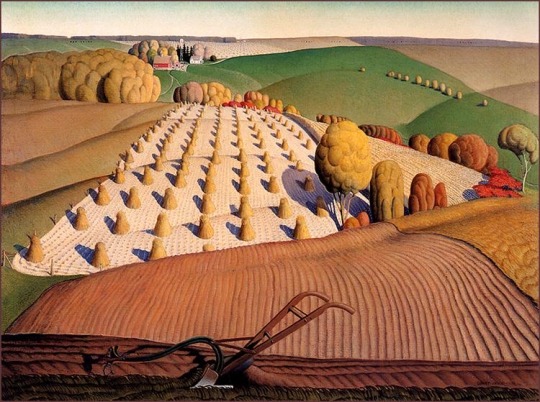
Grant Wood
Fall Plowing
1931
#grant wood#american artist#american art#american regionalism#american painting#american painter#regionalist#regionalist art#regionalism#landscape#landscape art#landscape painting#farm land#farming#modern art#art history#aesthetictumblr#tumblraesthetic#tumblrpic#tumblrpictures#tumblr art#aesthetic#beauty
17 notes
·
View notes
Text
Virtual Sketchbook #4:
1. WRITING, THINKING AND LOOKING CRITICALLY:
Jackson Pollock’s journey from studying with Thomas Hart Benton to creating his iconic drip paintings involved a shift from abstract imagery to complete abstraction. While under Benton’s support, Pollock was exposed to the fluidity and rhythm of the American Regionalist style, which influenced his early works that contained reoccurring figurative elements. However, exposure to Surrealist ideas and their focus on automatism prompted him to explore new approaches. So, Jackson Pollock had a break from traditional imagery which became apparent when he adopted the drip technique in his art. This involves poured or dripped paint onto a canvas laid on the floor. This method allowed for a more direct and physical engagement with the painting process, emphasizing a natural movement of the artist. Through this process, he transitioned from using abstract imagery to creating entirely abstract compositions, ultimately leading to his iconic “drip” paintings that embody Abstract Expressionism.
2. ART PROJECT - digital artwork

Ode to all the chaos in my mind of all the things I need to do.
0 notes
Photo
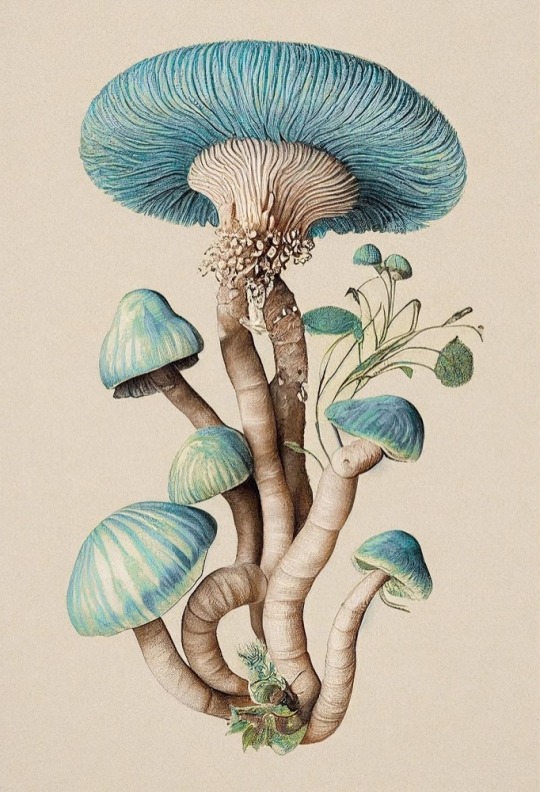
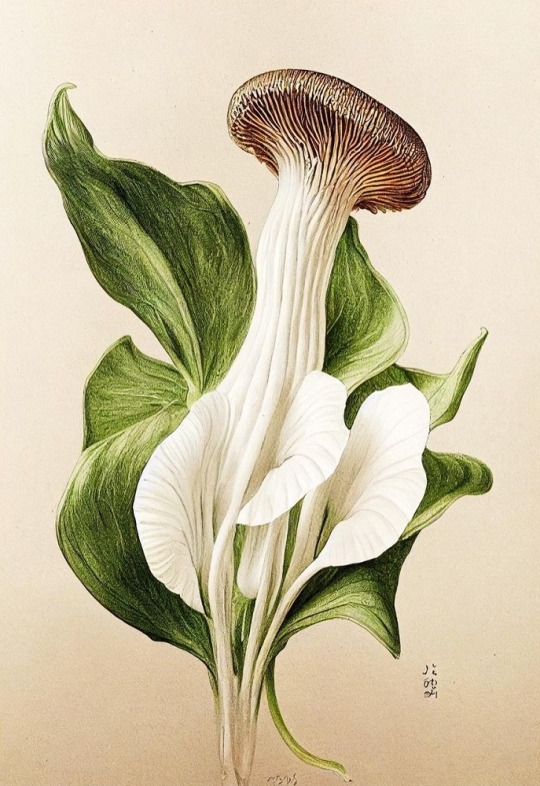


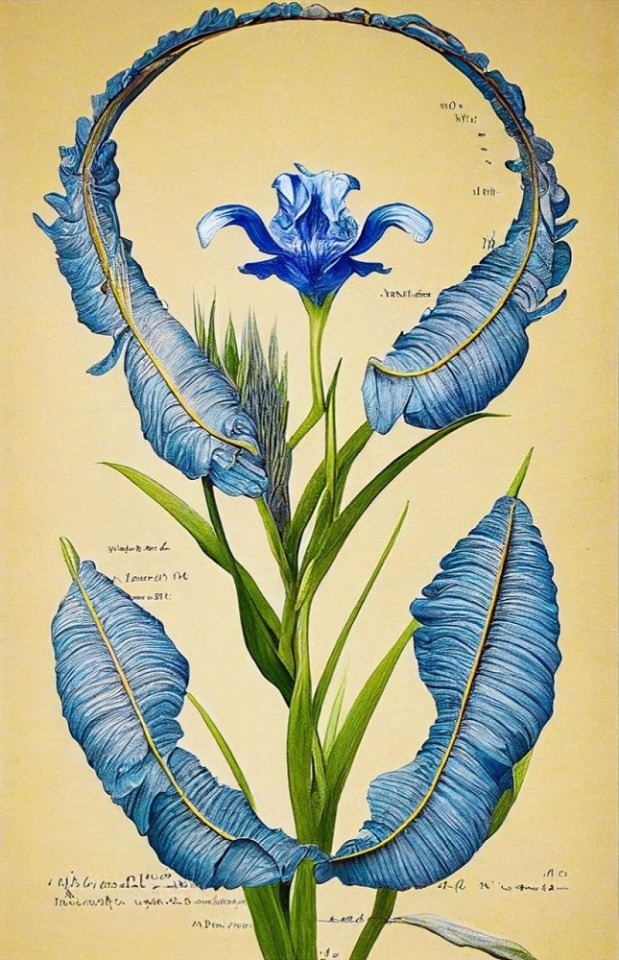
Mia Forrest
Full Moon Mushroom
Arum Oyster
Narcissus Cock
Honeypot Orchid
Joyful Iris
Botanical Studies / Foundation
#mia forrest#illustrations#botanical studies#IA#nft art#flowers are pretty#women artists#australian artist#regionalist flora
22 notes
·
View notes
Text
WRITING, THINKING AND LOOKING CRITICALLY
Jackson Pollock's evolution from studying with Thomas Hart Benton to pioneering his famous "drip" paintings involved a profound shift in his artistic approach and philosophical stance towards art. Initially influenced by Benton's regionalist style and figurative imagery, Pollock gradually began to break away from representational forms. This transition was marked by his exploration of abstract imagery, where he experimented with elements of form and color divorced from recognizable subject matter. However, it was his experimentation with the drip technique that culminated in the complete removal of imagery from his paintings. By allowing paint to drip, splatter, and flow freely onto the canvas, Pollock embraced spontaneity and chance, prioritizing the act of painting itself over any predetermined imagery. This shift towards non-representational expression allowed Pollock to delve deeper into the emotional and psychological dimensions of art, creating works that embodied raw energy and pure abstraction.
2. ART PROJECT
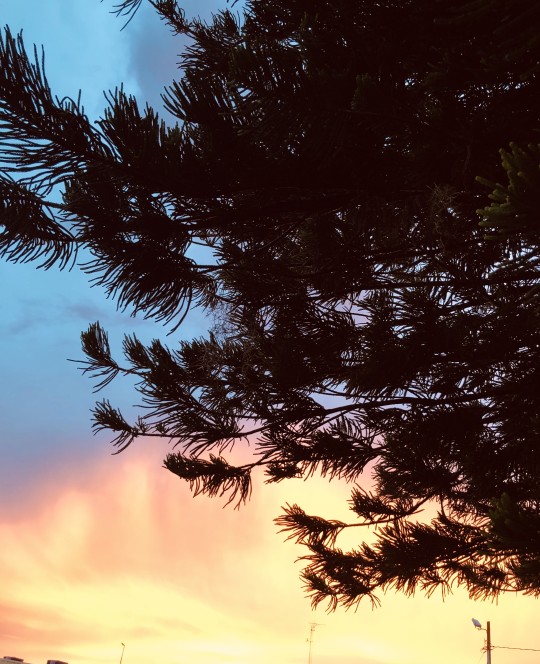
Title: Whispering Twilight
Description: In "Whispering Twilight," the evening sky becomes a canvas for the dance of light and shadow. The silhouette of the pine branches against the pastel hues of the sunset creates a captivating contrast, inviting viewers into a realm of quiet introspection. Abstract shapes and swirls blend seamlessly with the natural elements, blurring the lines between reality and imagination. As the day transitions into night, "Whispering Twilight" captures the fleeting beauty of the moment, where nature whispers its secrets to those who pause to listen.
0 notes
Text
VIRTUAL SKETCHBOOK # 4
1. WRITING, THINKING AND LOOKING CRITICALLY
Jackson Pollock's evolution from studying with Thomas Hart Benton to pioneering his famous "drip" paintings involved a profound shift in his artistic approach and philosophical stance towards art. Initially influenced by Benton's regionalist style and figurative imagery, Pollock gradually began to break away from representational forms. This transition was marked by his exploration of abstract imagery, where he experimented with elements of form and color divorced from recognizable subject matter. However, it was his experimentation with the drip technique that culminated in the complete removal of imagery from his paintings. By allowing paint to drip, splatter, and flow freely onto the canvas, Pollock embraced spontaneity and chance, prioritizing the act of painting itself over any predetermined imagery. This shift towards non-representational expression allowed Pollock to delve deeper into the emotional and psychological dimensions of art, creating works that embodied raw energy and pure abstraction.
2. ART PROJECT

Title: Celestial Harmony
This artwork captures the ethereal beauty of the evening sky, infused with a sense of tranquility and wonder. The interplay of light and shadow creates a mesmerizing contrast, while the soft hues of pink and purple evoke a feeling of serenity. The crescent moon and stars emerge as focal points, symbolizing the vastness of the cosmos and our connection to the universe. Abstract swirls and brushstrokes add a dynamic energy to the composition, mirroring the ever-changing nature of the night sky. Overall, "Celestial Harmony" invites viewers to contemplate the mysteries of the cosmos and find solace in its timeless elegance.
0 notes